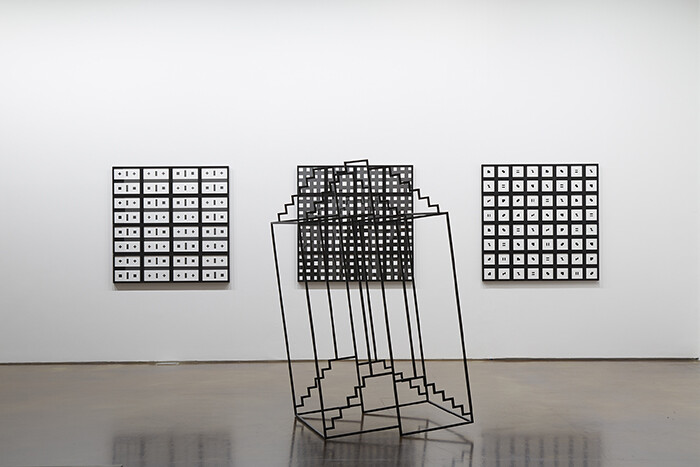Hong Seung Hye’s sixth solo exhibition at Kukje Gallery is a retrospective, after a fashion. Arrayed around K2—one of the Seoul gallery’s spaces—are prints, sculptures, and furniture that co-opt the titles and forms of her earlier works. The stainless steel structure in On & Off (all works 2014), for example, matches a previous sculpture made with red lacquer on wood; both create portraits of teetering, pixilated homes. Color has also drained from Debris, a set of dollhouse-like boxes that break rank with their 2008 forebears, preferring the floor to the wall, and steel to lacquered wood. It would seem that history—at least in Hong’s case—is best viewed in grayscale.
Entitled “Reminiscence,” Hong’s show is not a mere exercise in citation. While acknowledging that “the past is fixed,” the Korean artist also has an interest in evolutionary processes, leaving open how earlier artworks may be entailed in future ones. This interest dates as far back as 1997, when Hong began her ongoing “Organic Geometry” series, which explores the permutations of primary digital structures. Echoing the modernists, the artist started by working with the grid, though hers is not a site of transcendental abstraction, but a laboratory for formal experimentation, where pixels can germinate toward undetermined ends. For her part, Hong sets the coordinates on this virtual Cartesian plane: by exploiting the algebraic constraints of the interface, as well as facilitating the transformation of digital images into art objects.
As an end-point of this process, “Reminiscence” impresses for its formal diversity. In Organic Geometry, at one corner of the main gallery, three identical prints sit propped on a shelf. They feature a blocky structure quartered in an obnoxiously large “X” of a seeming expressivity that belies its pixel-laden facture. While specifically indexing their virtual origins, the prints imply that expression and negation are never without mediation. With these three images, the frames do part of the work, introducing difference through their respective black, grey, and white tones. The same is true for Hong’s pixel typologies from the “Organic Geometry” series: the inkjets hang cheek by jowl, making the frames mimic their printed grids. Both works find the artist economically dispensing with any distinction between artwork and support.
Elsewhere, other hierarchies come under review. The birch plywood Dancing Drawers seem untroubled by their position at the threshold of fine art and design. As one unit’s drawers remain straight-faced, the other’s zigzag with personality. The gallery goers seem equally untroubled; during my visit, two women investigated their contents.
Far more complicated is Reminiscence, a wall painting that brings the only splash of color to the exhibition. The work references an identically named wall painting from 2004, casting retrospection as an ongoing part of Hong’s work. One of the pixilated forms from the original piece has migrated onto an aluminum plate, which floats over the blue-grey wall like a specter. This color recurs on the gallery’s central column and facing wall, creating a plane that moves diagonally across the main space. Hong has previously referred to her wall paintings as “ready-made sculptures,” in how they attempt to appropriate institutional space. Though implicit in many of the artworks on view, Reminiscence emphatically sites Hong’s practice in the gap between institution and interface.
On the facing wall, Twin Round Frame’s two cut holes provide views of an exterior garden. Hong has installed two stools and a daybed on the grounds that are fashioned out of steel and pixel tiles. As with the wall painting, these apertures allow for the interpenetration of spaces: the institutional daybed can now function as a smoker’s lounge, and the gallery lies open to the heat and smells of a neighboring restaurant. Twin Round Frame thus brings a welcome degree of contingency to Hong’s exhibition, which, for all of its emphasis on uncertainty, can often feel constrained by operative forms. Indeed, by reaching beyond her signature procedures, Hong allows for every future retrospection to gain in complexity and scope.








